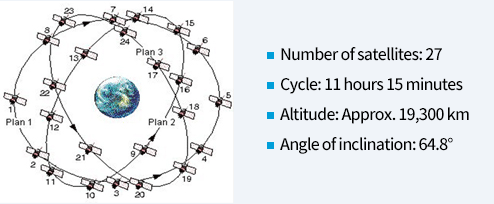Glossary
생활속의 위성항법, 보다 안전하게 제공하겠습니다!
Overview of GLONASS
GLONASS
A worldwide Russian global positioning system. developed by the former USSR and is currently operated by the Russian space force.

Modernization of GLONASS
Improvement of GLONASS performance
- Modernization of the satellite
- Expansion and modernization of parts on the ground
- Modernization of master station and built-in watch
- Improvement of its geodetic system
- Upgrade of its satellite's S/W and parts on the ground
Development of GLONASS
| Satellite | Operation | FDMA | CDMA | |||
|---|---|---|---|---|---|---|
| L1 | L2 | L1 | L2 | L3 | ||
| GKIBASS-M | 2003~ | L1OF LISF |
L2OF L2SF |
|||
| GKIBASS-K1 | 2011~ | L1OF LISF |
L2OF L2SF |
L3OC | ||
| GKIBASS-K2 | 2019~ | L1OF LISF |
L2OF L2SF |
L1OC LISC |
L2OC L2SC |
L3OC |
New GLONASS Blocks
GLONASS-M (compared to GLONASS)
- A new civilian signal of L2 band
- Increased satellite lifespan (7 years)
- Inter-satellite wireless link for improved integrity control and self-operating time
- Improved stability of built-in clock (1x10-13)
- Improved solar panel orientation
GLONASS-K
- New inter-CDMA signal of the L3 band
- Search and rescue services
- Increased satellite lifespan (10–12 years)
- Improved stability of built-in clock (1x10-14)
GLONASS-KM
- Requirements definition phase
- New, additional CDMA civilian signals of the L1 and L2 bands
| Total satellites in constellation | 27 SC |
|---|---|
| operational | 23 SC |
| In maintenance | 1 SC |
| Spares | 1 SC |
| In flinght tests phase | 2 SC |







